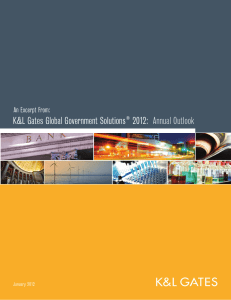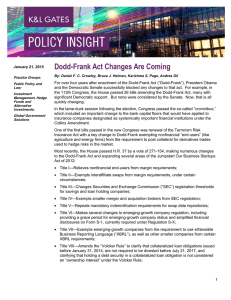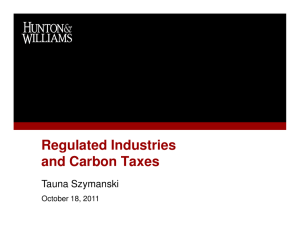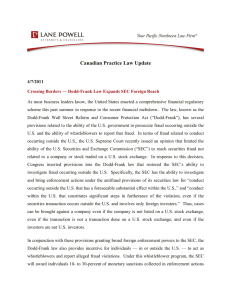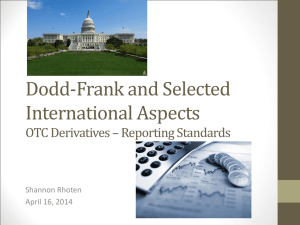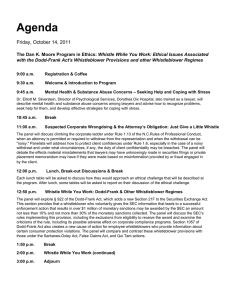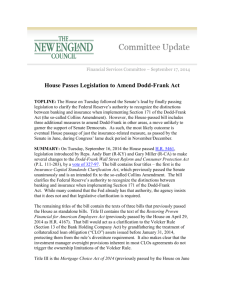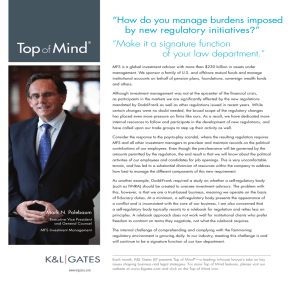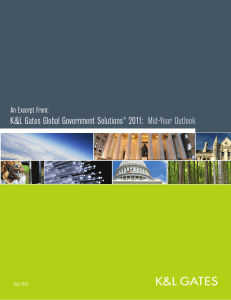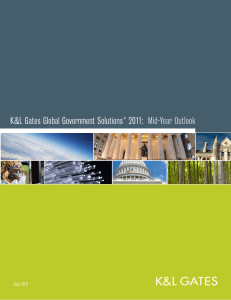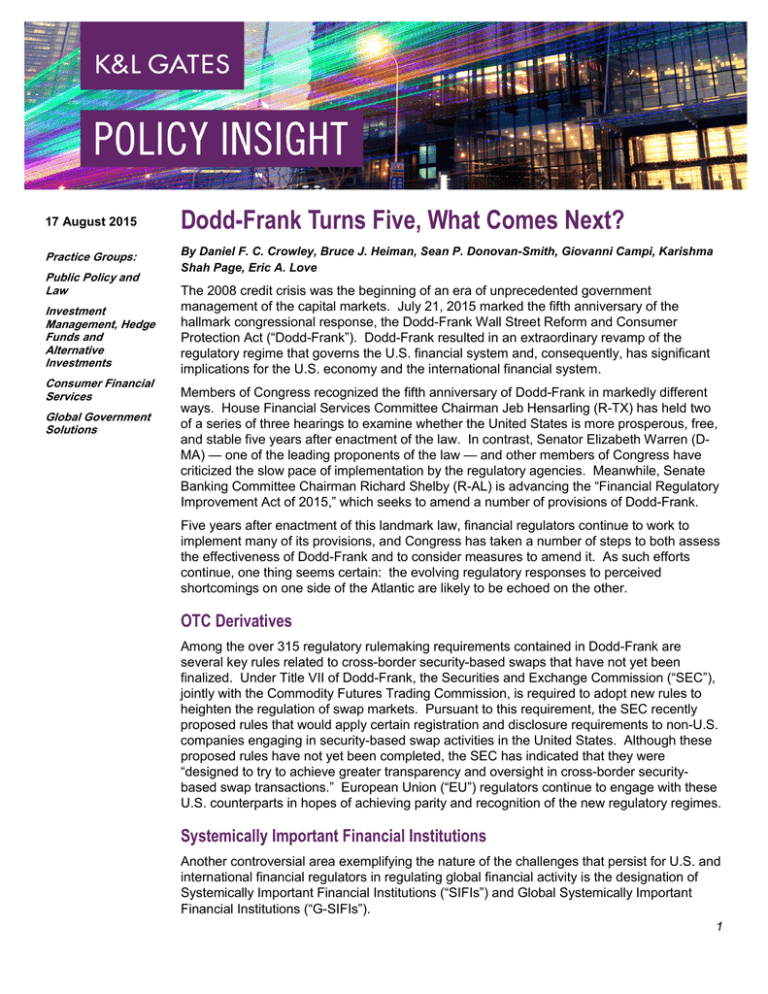
17 August 2015
Dodd-Frank Turns Five, What Comes Next?
Practice Groups:
By Daniel F. C. Crowley, Bruce J. Heiman, Sean P. Donovan-Smith, Giovanni Campi, Karishma
Shah Page, Eric A. Love
Public Policy and
Law
Investment
Management, Hedge
Funds and
Alternative
Investments
Consumer Financial
Services
Global Government
Solutions
The 2008 credit crisis was the beginning of an era of unprecedented government
management of the capital markets. July 21, 2015 marked the fifth anniversary of the
hallmark congressional response, the Dodd-Frank Wall Street Reform and Consumer
Protection Act (“Dodd-Frank”). Dodd-Frank resulted in an extraordinary revamp of the
regulatory regime that governs the U.S. financial system and, consequently, has significant
implications for the U.S. economy and the international financial system.
Members of Congress recognized the fifth anniversary of Dodd-Frank in markedly different
ways. House Financial Services Committee Chairman Jeb Hensarling (R-TX) has held two
of a series of three hearings to examine whether the United States is more prosperous, free,
and stable five years after enactment of the law. In contrast, Senator Elizabeth Warren (DMA) — one of the leading proponents of the law — and other members of Congress have
criticized the slow pace of implementation by the regulatory agencies. Meanwhile, Senate
Banking Committee Chairman Richard Shelby (R-AL) is advancing the “Financial Regulatory
Improvement Act of 2015,” which seeks to amend a number of provisions of Dodd-Frank.
Five years after enactment of this landmark law, financial regulators continue to work to
implement many of its provisions, and Congress has taken a number of steps to both assess
the effectiveness of Dodd-Frank and to consider measures to amend it. As such efforts
continue, one thing seems certain: the evolving regulatory responses to perceived
shortcomings on one side of the Atlantic are likely to be echoed on the other.
OTC Derivatives
Among the over 315 regulatory rulemaking requirements contained in Dodd-Frank are
several key rules related to cross-border security-based swaps that have not yet been
finalized. Under Title VII of Dodd-Frank, the Securities and Exchange Commission (“SEC”),
jointly with the Commodity Futures Trading Commission, is required to adopt new rules to
heighten the regulation of swap markets. Pursuant to this requirement, the SEC recently
proposed rules that would apply certain registration and disclosure requirements to non-U.S.
companies engaging in security-based swap activities in the United States. Although these
proposed rules have not yet been completed, the SEC has indicated that they were
“designed to try to achieve greater transparency and oversight in cross-border securitybased swap transactions.” European Union (“EU”) regulators continue to engage with these
U.S. counterparts in hopes of achieving parity and recognition of the new regulatory regimes.
Systemically Important Financial Institutions
Another controversial area exemplifying the nature of the challenges that persist for U.S. and
international financial regulators in regulating global financial activity is the designation of
Systemically Important Financial Institutions (“SIFIs”) and Global Systemically Important
Financial Institutions (“G-SIFIs”).
1
Dodd-Frank Turns Five, What Comes Next?
In the United States, Congress continues to debate the role of the Financial Stability
Oversight Council (“FSOC”) and its exercise of its authority under Dodd-Frank to designate
SIFIs. Although the systemic risk posed by large, interconnected financial institutions is a
perennial concern shared by both Democrats and Republicans in Congress, differences
remain about how and whether certain institutions should be designated. For example,
Senator Shelby’s financial reform legislation includes provisions that would increase the
threshold for the automatic designation of SIFIs from $50 billion in assets to $500 billion.
These provisions have been roundly criticized by some Democrats in Congress and have
been met with firm resistance from Obama Administration officials.
On the international front, earlier this year the Financial Stability Board (“FSB”) and the
International Organization of Securities Commissions (“IOSCO”) published their second
public consultation, which outlines a methodology to assess whether to designate asset
managers as G-SIFIs. More recently, the FSB announced its decision to wait to finalize the
assessment methodologies for nonbank, non-insurer G-SIFIs until its work on financial
stability risks from asset management activities is completed. The influence of international
developments on domestic financial services policy is a new dimension post-Dodd-Frank, as
Republican members of the House Financial Services Committee have also raised concerns
about the extent to which the FSB influences the FSOC’s SIFI designation process. This will
undoubtedly continue to be an area of congressional interest in the future. A key issue going
forward is whether global regulators will diverge on the question of whether asset managers
pose systemic risk.
Investor Protection
The SEC recently approved a pay ratio disclosure rule that it proposed in 2013, which will
require public companies to disclose the ratio of the annual total compensation of the chief
executive officer to the median of the annual total compensation of the company’s
employees. In addition, the SEC has proposed so-called “claw back” rules that would
require corporate executive officers to pay back incentive-based compensation that had
been awarded erroneously. Since a federal court threw out the SEC’s so-called “proxy
access” rule in 2011, there has been renewed discussion among shareholder advocates,
regulators, and lawmakers about whether the SEC should write a new proxy access rule to
make it easier for shareholders to nominate corporate directors. While members of
Congress have recently pressed the SEC to do more about proxy access reforms, SEC
Chair Mary Jo White suggested in a March 24, 2015 House Financial Services Committee
hearing that the SEC does not currently intend to try to rewrite such a rule. Moving forward,
members of Congress will likely continue to monitor the pace of rulemaking and examine on
a substantive basis the potential effect of proposed rules. Institutional investors will continue
to press for reforms on both sides of the Atlantic.
Consumer Financial Protection Bureau
Among the most controversial Dodd-Frank issues that remains a subject of considerable
debate in Congress is the organizational and funding structure of the Consumer Financial
Protection Bureau (“CFPB”). Senator Warren and the authors of Dodd-Frank envisioned the
CFPB as the equivalent of the Consumer Product Safety Commission for financial products.
While Democrats have touted the CFPB as a strong consumer watchdog that has returned
billions of dollars to consumers, Republicans are pursuing legislation that would subject the
2
Dodd-Frank Turns Five, What Comes Next?
CFPB to the congressional appropriations process and that would put in place a bipartisan
five-member commission, instead of the existing single director, to lead the agency.
Opponents argue that these measures would weaken the CFPB and impede its ability to
carry out its mandate under Dodd-Frank. Congress will likely continue to consider these and
similar measures to modify the CFPB in the future.
Other International Developments
Just as Dodd-Frank implementation and debate continues, so too do comprehensive reform
efforts in the EU. Notably, the European Commission (“EC”) is expected to release an
“Action Plan” in September 2015 to follow up on its ambitious “Green Paper” consultation
launched earlier this year for a Capital Markets Union (“CMU”). An essential objective of the
CMU, which is loosely modeled on U.S. capital markets but taking firmly into account
European specificities, is to create a single market for capital by removing barriers to crossborder investments and diversifying funding of the European economy.
In addition to efforts to address systemic risk, the FSB also recently published a report that
analyzes progress toward its recommendations for reforms to existing major interest rate
benchmarks (such as LIBOR, EURIBOR, and TIBOR). Moreover, the report examines
progress on the development and introduction of near risk-free interest rate benchmarks (or
RFRs). Like the FSB, the EC, IOSCO, and others have focused on trying to ensure the
integrity of benchmarks and have proposed to make benchmarks more reliable and less
vulnerable to manipulation. The European Parliament and the EU member states are
currently discussing a new EU regulatory regime for “benchmarks,” including indexes. There
is an open question as to whether U.S. regulators will consider the regulation of indexes.
Under Basel III, a comprehensive set of capital measures, the Basel Committee on Banking
Supervision has moved to implement several notable financial reforms. In particular, the
Basel Committee issued a final standard to require banks to maintain a net stable funding
ratio (“NSFR”) in relation to their on- and off-balance sheet activities. The NSFR is expected
to become a minimum standard by January 1, 2018. Importantly, the Basel Committee has
also issued a Liquidity Coverage Ratio to help ensure that banks have a sufficient level of
high-quality liquid assets that can be readily converted to cash in private markets to meet the
institution’s liquidity needs for a 30-calendar-day liquidity stress situation.
Recently, calls for a financial transactions tax in the EU have reverberated in the United
States, with several members of Congress publicly expressing support for such a tax to curb
excessive risk-taking in the financial sector.
Conclusion
Five years after enactment of Dodd-Frank, the policy debates among policymakers continue
to echo on both sides of the Atlantic. These debates center on the proper balance between
the efficient allocation of capital through informed assumption of risk by investors on the one
hand, and preserving the safety and soundness of the financial system by controlling risk on
the other. The tension between these regulatory considerations not only helps to explain
many of the transatlantic debates, but also presents opportunities for impacted stakeholders
to influence them by advocating for sound and responsive policy solutions. In the United
States, several Republican members of Congress have publicly noted their intent to actively
pursue a strategy of attaching measures to amend Dodd-Frank to “must pass” legislation (on
3
Dodd-Frank Turns Five, What Comes Next?
the heels of successfully repealing the so-called “swaps pushout” rule late last year).
Toward that end, Senator Shelby recently included his financial reform legislation in a
spending measure that cleared the full Senate Appropriations Committee on a party-line
vote. Regardless of whether such efforts are ultimately successful, five years after
enactment of Dodd-Frank, it is clear that the global debate over the scale and scope of
financial regulation will continue.
Authors:
Daniel F. C. Crowley
Bruce J. Heiman
Sean P. Donovan-Smith
dan.crowley@klgates.com
+1.202.778.9447
bruce.heiman@klgates.com
+1.202.661.3935
sean.donovan-smith@klgates.com
+44.(0)20.7360.8202
Giovanni Campi
Karishma Shah Page
Eric A. Love
giovanni.campi@klgates.com
+32.(0).2.336.1910
karishma.page@klgates.com
+1.202.778.9128
eric.love@klgates.com
+1.202.778.9415
Anchorage Austin Beijing Berlin Boston Brisbane Brussels Charleston Charlotte Chicago Dallas Doha Dubai Fort Worth Frankfurt
Harrisburg Hong Kong Houston London Los Angeles Melbourne Miami Milan Moscow Newark New York Orange County Palo Alto Paris
Perth Pittsburgh Portland Raleigh Research Triangle Park San Francisco São Paulo Seattle Seoul Shanghai Singapore Spokane
Sydney Taipei Tokyo Warsaw Washington, D.C. Wilmington
K&L Gates comprises more than 2,000 lawyers globally who practice in fully integrated offices located on five
continents. The firm represents leading multinational corporations, growth and middle-market companies, capital
markets participants and entrepreneurs in every major industry group as well as public sector entities, educational
institutions, philanthropic organizations and individuals. For more information about K&L Gates or its locations,
practices and registrations, visit www.klgates.com.
This publication is for informational purposes and does not contain or convey legal advice. The information herein should not be used or relied upon in
regard to any particular facts or circumstances without first consulting a lawyer.
© 2015 K&L Gates LLP. All Rights Reserved.
4

